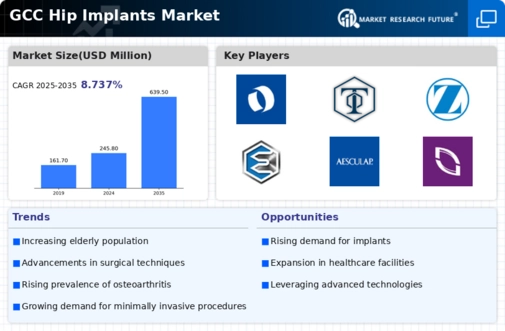Aging Population in GCC
The aging population in the GCC region is a primary driver for the hip implants market. As life expectancy increases, the prevalence of age-related conditions such as osteoarthritis and hip fractures rises. This demographic shift indicates a growing need for hip replacement surgeries, which are often necessary for maintaining mobility and quality of life. According to recent statistics, the population aged 65 and older in GCC countries is projected to reach 10% by 2030. This trend suggests a substantial increase in demand for hip implants, as older individuals are more likely to require surgical interventions. Consequently, the hip implants market is expected to expand significantly to accommodate this demographic shift, leading to increased investments in healthcare infrastructure and orthopedic services.
Rising Healthcare Expenditure
Rising healthcare expenditure in the GCC region is another significant driver for the hip implants market. Governments and private sectors are increasingly investing in healthcare services, leading to improved access to advanced medical technologies. In 2025, healthcare spending in GCC countries is estimated to reach approximately $100 billion, reflecting a growth rate of around 7% annually. This increase in funding allows for the procurement of high-quality hip implants and the establishment of specialized orthopedic centers. As a result, the hip implants market is likely to benefit from enhanced surgical capabilities and a wider range of implant options, ultimately improving patient outcomes and satisfaction.
Government Initiatives and Policies
Government initiatives and policies aimed at improving healthcare access and quality are significantly influencing the hip implants market. In the GCC, various governments are implementing strategies to enhance healthcare infrastructure, including the establishment of specialized orthopedic centers and the promotion of medical tourism. These initiatives are designed to attract international patients seeking high-quality hip replacement surgeries. As a result, the hip implants market is poised for growth, with increased opportunities for collaboration between public and private sectors. Furthermore, favorable reimbursement policies for hip implant procedures are likely to encourage more patients to seek surgical interventions, further driving market expansion.
Increasing Awareness of Joint Health
Increasing awareness of joint health among the population in the GCC is driving the hip implants market. Educational campaigns and health initiatives are promoting the importance of maintaining joint function and addressing issues such as arthritis early on. As individuals become more informed about treatment options, including hip replacement surgeries, the demand for hip implants is expected to rise. This heightened awareness is particularly relevant in urban areas, where lifestyle-related conditions are more prevalent. The hip implants market is likely to benefit from this trend, as healthcare providers respond to the growing need for preventive care and timely interventions.
Technological Innovations in Orthopedics
Technological innovations in orthopedics are transforming the hip implants market. Advancements in materials science, such as the development of biocompatible materials and 3D printing, are enhancing the performance and longevity of hip implants. These innovations allow for customized implants tailored to individual patient anatomy, which may lead to better surgical outcomes. Furthermore, the integration of robotics and minimally invasive surgical techniques is streamlining procedures, reducing recovery times, and minimizing complications. The hip implants market is likely to see a surge in demand for these advanced solutions, as healthcare providers aim to offer cutting-edge treatments that align with patient expectations for effective and efficient care.

















Leave a Comment